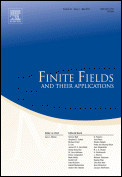
FINITE FIELDS AND THEIR APPLICATIONS
Scope & Guideline
Bridging Theory and Practice in Mathematical Sciences.
Introduction
Aims and Scopes
- Coding Theory:
The journal showcases research on various coding techniques, including linear codes, cyclic codes, BCH codes, and MDS codes, with a focus on their construction, decoding algorithms, and error-correcting capabilities. - Cryptography:
A significant focus is placed on the use of finite fields in cryptographic protocols and constructions, including studies on permutation polynomials, elliptic curve cryptography, and secure coding methods. - Combinatorial Designs:
Research in combinatorial designs, such as difference sets and balanced incomplete block designs, is prominently featured, emphasizing their mathematical properties and applications. - Algebraic Geometry and Number Theory:
The journal covers topics related to algebraic geometry codes, curves over finite fields, and number-theoretic aspects of finite fields, exploring their connections and implications. - Polynomial Functions:
There is a strong interest in the study of polynomial functions over finite fields, including permutation polynomials and their applications in cryptography and coding theory. - Graph Theory:
The journal includes research on graph theory applications related to finite fields, such as Cayley graphs and their properties, contributing to both combinatorial and algebraic insights.
Trending and Emerging
- Advanced Cryptographic Techniques:
There is a growing emphasis on advanced cryptographic techniques utilizing finite fields, including lattice-based cryptography and post-quantum cryptographic schemes, reflecting the need for secure methods in the face of evolving technological challenges. - Applications in Machine Learning and Data Science:
Recent publications indicate an increasing interest in applying finite fields to machine learning algorithms and data science, utilizing their properties for improved data encoding and error correction. - Quantum Coding Theory:
Research related to quantum codes and their construction using finite fields is gaining traction, driven by the need for error-correcting codes in quantum computing applications. - Interdisciplinary Approaches:
The integration of finite fields with other mathematical disciplines, such as topology and algebraic geometry, is emerging as a trend, leading to novel insights and methodologies. - Algorithmic and Computational Methods:
A noticeable increase in algorithmic studies related to finite fields, including efficient computation techniques for polynomials and codes, highlights a trend towards practical applications and computational efficiency.
Declining or Waning
- Elementary Number Theory:
Research related to basic number-theoretic properties of finite fields, such as prime factorization and divisibility, has become less prominent, possibly due to the increasing complexity and abstraction in current studies. - Classical Algebraic Structures:
Topics focusing on classical algebraic structures like simple groups and their properties in the context of finite fields have seen a reduction in publication frequency, as researchers gravitate towards more applied and computational aspects. - Elementary Combinatorial Designs:
While combinatorial designs remain a focus, elementary constructions and classical results have declined in favor of more complex and generalized frameworks that incorporate modern algebraic techniques.
Similar Journals
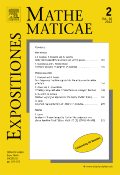
EXPOSITIONES MATHEMATICAE
Fostering Original Research in Diverse Mathematical FieldsEXPOSITIONES MATHEMATICAE, published by Elsevier GmbH, stands as a significant journal in the realm of mathematics, catering primarily to researchers, professionals, and students. With an ISSN of 0723-0869 and an E-ISSN of 1878-0792, this journal has made its mark in the academic community, boasting a Q2 classification in the miscellaneous mathematics category for 2023, illustrating its prominence within its field. The journal addresses a diverse scope of mathematical topics, encouraging the publication of original research and innovative theories while maintaining rigorous academic standards. As it converges from 2004 to 2024, EXPOSITIONES MATHEMATICAE continues to be an essential resource for advancing mathematical knowledge and fostering scholarly communication, despite being a non-open-access publication. Its location in Munich, Germany further anchors it within a rich intellectual tradition, providing accessibility for the mathematical community worldwide.

Notes on Number Theory and Discrete Mathematics
Pioneering Research in Mathematical InnovationNotes on Number Theory and Discrete Mathematics is a distinguished journal published by the BULGARIAN ACADEMY OF SCIENCE, dedicated to advancing research in the fields of number theory and discrete mathematics. Renowned for its scholarly contributions, this journal serves as a platform for researchers, professionals, and students to disseminate their findings and engage in critical discourse. The journal’s ISSN is 1310-5132 and its E-ISSN is 2367-8275, enhancing its visibility and accessibility in the academic community. While it currently operates under traditional access constraints, the journal is committed to fostering an open exchange of ideas and methodologies that drive innovation in mathematical research. By focusing on theoretical developments and applications, Notes on Number Theory and Discrete Mathematics plays a pivotal role in the ongoing exploration of mathematical principles, appealing to a broad audience and helping to shape the future of the discipline.

SIAM Journal on Applied Algebra and Geometry
Pioneering Research in Algebra and Geometric ApplicationsSIAM Journal on Applied Algebra and Geometry, published by SIAM Publications, is a premier academic journal that occupies a vital space in the fields of Algebra, Geometry, and Applied Mathematics. With an impressive impact factor reflected in its Q1 category rankings in 2023 across key mathematical disciplines such as Algebra and Number Theory, as well as Geometry and Topology, this journal is positioned among the highest echelons of mathematical research. Since its inception in 2017, it has become a crucial source for advanced studies and applied techniques that harness algebraic and geometric methods, catering to both theoretical insights and practical applications. Researchers, professionals, and students alike benefit from its rigorous peer-reviewed articles that explore contemporary challenges and developments in mathematics. While Open Access options are currently not available, the journal remains dedicated to fostering innovation and knowledge dissemination within the scientific community, thus ensuring significant contributions to the advancement of the mathematical sciences.

JOURNAL OF ALGEBRAIC COMBINATORICS
Pioneering insights at the intersection of algebra and combinatorics.JOURNAL OF ALGEBRAIC COMBINATORICS, published by SPRINGER, stands as a premier resource in the fields of algebra and combinatorics, playing a pivotal role in advancing research in these disciplines. With an esteemed impact factor reflective of its academic rigor, it holds a prestigious Q1 ranking in both Algebra and Number Theory, as well as in Discrete Mathematics and Combinatorics, according to 2023 assessments. Established in 1992, this journal features contributions from leading experts worldwide, offering insights into the latest developments and methodologies. Although not an open-access journal, it provides a wealth of valuable information and research findings focusing on combinatorial structures, theory, and applications that are essential for advancing academic inquiry. As a vital publication for researchers, professionals, and students alike, JOURNAL OF ALGEBRAIC COMBINATORICS continues to shape the conversation within the mathematical community and beyond, making it indispensable for those engaged in the dynamic landscape of mathematical sciences.
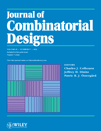
JOURNAL OF COMBINATORIAL DESIGNS
Fostering Insights in Combinatorial Theory and PracticeJOURNAL OF COMBINATORIAL DESIGNS, published by Wiley, is a leading peer-reviewed journal that serves as a vital platform for researchers in the field of discrete mathematics and combinatorics. With an impressive Q1 ranking in the 2023 category, it stands at the forefront of academic discourse, showcasing significant developments and innovative research from 1993 to 2024. The journal is dedicated to the study of combinatorial designs, including their applications in various scientific disciplines, which enhances its relevance among mathematicians and applied scientists alike. Although it operates on a traditional subscription model, the journal continues to attract high-quality submissions, as evidenced by its Scopus rank of #40 out of 92 in Discrete Mathematics and Combinatorics, placing it in the 57th percentile. Its commitment to advancing knowledge in combinatorial theory and applications makes it an essential resource for professionals, researchers, and students seeking to deepen their understanding and contribute to this dynamic field.
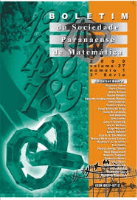
Boletim Sociedade Paranaense de Matematica
Connecting Minds Through Mathematical ExcellenceBoletim Sociedade Paranaense de Matematica is a distinguished journal within the field of Mathematics, published by the Sociedade Paranaense de Matemática in Brazil. With an ISSN of 0037-8712 and an E-ISSN of 2175-1188, this journal has been committed to fostering open access to mathematical research since 2002, ensuring that cutting-edge research is readily available to the academic community. Operating within the diverse landscape of mathematical studies and ranked Q3 for 2023 in the category of Mathematics (Miscellaneous), the journal serves as a platform for innovative contributions and discussions. It ranks 192nd out of 399 in the Scopus database for General Mathematics, reflecting its steady involvement in the global academic dialogue. The Boletim resides at JD AMERICAS, CAIXA POSTAL 19081, CURITIBA PR 81531-990, Brazil, and aims to connect researchers, practitioners, and students by promoting high-quality research and dissemination of mathematical knowledge. By bridging diverse mathematical theories and applications, the journal not only enhances understanding of the discipline but also drives future research directions.
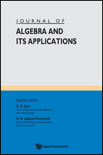
JOURNAL OF ALGEBRA AND ITS APPLICATIONS
Advancing Mathematical Knowledge Through Rigorous ResearchJOURNAL OF ALGEBRA AND ITS APPLICATIONS, published by WORLD SCIENTIFIC PUBL CO PTE LTD, stands as a pivotal resource for scholars in the fields of Algebra and Applied Mathematics. With an ISSN of 0219-4988 and E-ISSN 1793-6829, this journal has been providing a forum for the dissemination of cutting-edge research since its inception in 2008, converging towards a forward-looking timeline extending to 2024. As of 2023, it has earned a commendable Q2 ranking in both Algebra and Number Theory, as well as Applied Mathematics, reflecting its solid impact within the mathematical community. With a Scopus rank of #49/119 in Algebra and Number Theory, and #420/635 in Applied Mathematics, the journal captures significant advancements and applications across various mathematical domains. While it does not operate under an open access model, its comprehensive articles and research outputs are crucial for fostering intellectual dialogue and innovation in academia. Researchers, professionals, and students alike will find this journal an indispensable asset for their scientific pursuits and explorations into the vast field of mathematics.

Advances in Mathematics of Communications
Unlocking the Potential of Mathematical CommunicationsAdvances in Mathematics of Communications, published by the American Institute of Mathematical Sciences (AIMS), is a leading journal dedicated to the dissemination of high-quality research in the fields of algebra, number theory, applied mathematics, discrete mathematics, combinatorics, and computer networks. Established in 2008, this journal has quickly established itself as a significant contributor to mathematical communications, holding a reputable position in the Scopus rankings, with impressive category quartiles, including Q2 rankings in key areas such as Algebra and Number Theory and Applied Mathematics. Besides its rigorous peer-review process, the journal facilitates the growth of innovative ideas and methodologies that bridge the gap between theory and application. With no open access restrictions, Advances in Mathematics of Communications aims to provide an inclusive platform for researchers, professionals, and students to share their findings and insights, fostering collaboration and advancing the global knowledge base in the mathematical sciences. The journal's commitment to excellence ensures its role as an essential resource in the ever-evolving landscape of mathematics.

Periodica Mathematica Hungarica
Illuminating the Path of Mathematical Discovery.Periodica Mathematica Hungarica is a prestigious academic journal published by Springer, focusing on the field of mathematics, with a particular emphasis on miscellaneous mathematical studies. Established in 1971, this journal has maintained its commitment to advancing mathematical research and its applications, making significant contributions over its converged years through 2024. With a Q2 ranking in the mathematics category as of 2023, it establishes itself as a vital resource within the mathematical community. Researchers and academics will find its inclusion in the Scopus database, ranking #189 out of 399 in general mathematics, indicative of its impact and relevance. Although it does not feature open access, the journal provides a wealth of high-quality peer-reviewed articles, thereby serving as an essential platform for the dissemination of innovative mathematical theories, methodologies, and findings. Engaging with the content of Periodica Mathematica Hungarica is crucial for anyone looking to stay at the forefront of mathematical research and development.

Analele Stiintifice ale Universitatii Ovidius Constanta-Seria Matematica
Innovating in Mathematics: Your Gateway to High-Quality ResearchAnalele Stiintifice ale Universitatii Ovidius Constanta-Seria Matematica is a prominent open-access journal established by OVIDIUS UNIV PRESS in Romania, dedicated to advancing the fields of mathematics, specifically in Analysis and Applied Mathematics. Since its inception, the journal has emphasized the dissemination of high-quality research, making it accessible to a global audience. With an ISSN of 1224-1784 and E-ISSN 1844-0835, it has positioned itself within the academic community, achieving a respectable Q3 ranking in both analysis and applied mathematics in 2023, reflecting its commitment to rigorous scholarship. The journal spans a considerable publication window from 2009 to 2024, catering to the ongoing developments in mathematical sciences and their applications. Researchers, professionals, and students alike will find valuable insights and contributions that enrich their understanding and foster collaboration within the mathematical community. The journal's headquarters is based at the Faculty of Mathematics & Computer Science, Bulevardul Mamaia 124, Constanta, Romania.